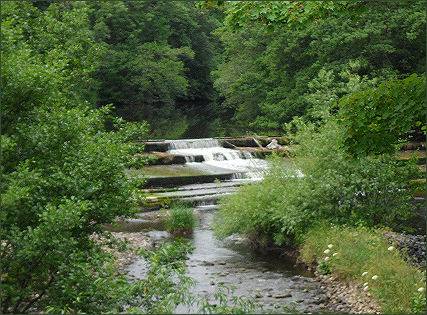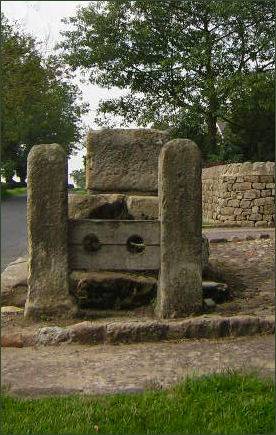Hampsthwaite
OS grid reference:- SE 259 587
 The pretty village of Hampsthwaite, is situated just outside the Nidderdale Area of Outstanding Natural Beauty and lies on the south bank of River Nidd, 5 miles from the spa town of Harrogate.
The pretty village of Hampsthwaite, is situated just outside the Nidderdale Area of Outstanding Natural Beauty and lies on the south bank of River Nidd, 5 miles from the spa town of Harrogate.
The centre of Hampsthwaite is designated as a Conservation Area and has a Village Room, a Memorial Hall, a post office, a shop, and a pub, the Joiners' Arms.
The earliest written reference to the village dates from circa 1180, where it is recorded as 'Hamethwayt'. The name 'Thwaite' derives from the Old Norse word 'thveit', meaning clearing, meadow or paddock, Hampsthwaite may mean the thwaite, or meadow, of Hamr or Hammall. An alternative theory is that 'Hamps' may have come from from the Middle English word, 'Hanespe', which means 'summer dry'.
 Hampsthwaite was once situated in the ancient Forest of Knaresborough, which was established as a royal hunting preserve during the reign of William the Conqueror. The church of Hampsthwaite was in existence soon after the Norman Conquest and was at one time owned by the monks of Knaresborough. In 1304, King Edward I granted a charter to the village to hold an annual market and fair on the Feast of St Thomas the Martyr.
Hampsthwaite was once situated in the ancient Forest of Knaresborough, which was established as a royal hunting preserve during the reign of William the Conqueror. The church of Hampsthwaite was in existence soon after the Norman Conquest and was at one time owned by the monks of Knaresborough. In 1304, King Edward I granted a charter to the village to hold an annual market and fair on the Feast of St Thomas the Martyr.
The centre of the villlage retains its old worlde charm with attractive stone cottages nestling round the village green and water pump, while an ancient bridge spans the River Nidd.
The parish church is deicated to St Thomas a Becket, the first known church to occupy the site was probably completed in about 1180 and is thought to have been constructed by Hugh de Morville the then Constable of Knaresborough Castle and one of the four knights who carried out the murder of Archbishop Thomas Becket at Canterbury Cathedral in 1170.
The church was rebuilt sometime between the middle of the fourteenth and the beginning of the fifteenth centuries. The nave and chancel were again rebuilt in the 1820's.
The two sepulchral stones or grave covers near the west door and behind the lectern. They were discovered during the restoration of the in 1901. Located beneath the foundations, these were identified as Saxon or early Norman in design and workmanship. Several of them had been incised with crosses in the Celtic style.
The large rough stone font is believed to date from the Norman period, while the pulpit is Jacobean. In the churchyard are the graves of members of the Thackeray family, from whom William Makepeace Thackeray (1811-1863) of Vanity Fair fame was descended, there is also the grave of Joshua Tetley, the founder of the Tetley's Brewery in Leeds, and his wife Hannah.
